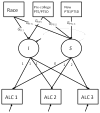Longitudinal investigation of interpersonal trauma exposure and alcohol use trajectories
- PMID: 26454552
- PMCID: PMC4699169
- DOI: 10.1016/j.addbeh.2015.09.014
Longitudinal investigation of interpersonal trauma exposure and alcohol use trajectories
Abstract
Background: The current longitudinal study examined associations between interpersonal potentially traumatic events (PTEs; i.e., sexual or physical assault) and changes in alcohol consumption among incoming college students.
Methods: 1197 students (68% female) participating in a university-wide research study were included in analyses. Assessments were administered at three time-points and included measures of alcohol use, PTEs (Life Events Checklist), and a screener for possible PTSD symptoms (abbreviated Primary Care PTSD Screen). Linear growth curve models were fit to the three repeated measures of alcohol quantity and frequency to determine the role of pre-college and college-onset interpersonal PTEs and possible PTSD symptoms on patterns of alcohol use.
Results: Pre-college interpersonal PTE was associated with greater baseline alcohol use for female but not male students. College-onset interpersonal PTE predicted greater alcohol use at concurrent and future assessments for women but not men, beyond the effects of pre-college PTE. Pre-college possible PTSD symptoms did not predict baseline or change in alcohol use.
Conclusions: There may be a stronger and longer-lasting impact of interpersonal PTE for college women compared to men on alcohol phenotypes, although replication in studies oversampling men endorsing interpersonal PTE is needed.
Keywords: Alcohol; Physical assault; Posttraumatic stress disorder; Sexual assault; Trauma.
Copyright © 2015 Elsevier Ltd. All rights reserved.
Conflict of interest statement
The authors have nothing to disclose.
Figures


References
-
- Bollen KA, Curran PJ. Latent Curve Models: A Structural Equation Perspective. Hoboken, NJ: John Wiley & Sons, Inc; 2006.
-
- Chilcoat HD, Breslau N. Posttraumatic stress disorder and drug disorders: testing causal pathways. Archives of General Psychiatry. 1998;55:913–917. - PubMed
-
- Coffey SF, et al. Trauma and substance cue reactivity in individuals with comorbid posttraumatic stress disorder and cocaine or alcohol dependence. Drug and Alcohol Dependence. 2002;65(2):115–127. - PubMed
Publication types
MeSH terms
Grants and funding
- K02AA018755/AA/NIAAA NIH HHS/United States
- T32 MH020030/MH/NIMH NIH HHS/United States
- R01 AA020179/AA/NIAAA NIH HHS/United States
- P20AA107828/AA/NIAAA NIH HHS/United States
- UL1RR031990/RR/NCRR NIH HHS/United States
- UL1 RR031990/RR/NCRR NIH HHS/United States
- P60 MD002256/MD/NIMHD NIH HHS/United States
- K02 AA018755/AA/NIAAA NIH HHS/United States
- R37 AA011408/AA/NIAAA NIH HHS/United States
- K02 AA023239/AA/NIAAA NIH HHS/United States
- R01 MH101518/MH/NIMH NIH HHS/United States
- R00 AA022385/AA/NIAAA NIH HHS/United States
- R37AA011408/AA/NIAAA NIH HHS/United States
LinkOut - more resources
Full Text Sources
Other Literature Sources
Medical

